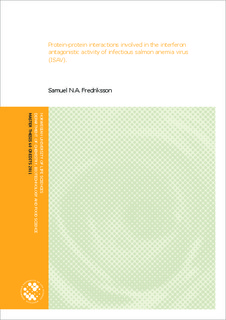| dc.description.abstract | Infeksiøs lakseanemi virus (ILAV) er et akvatisk influensa-lignende virus som infiserer Atlantisk laks og forårsaker stor dødlighet. Til nå er det ikke utviklet effektive vaksiner som gir god beskyttelse mot ILAV. Utbrudd av nye virulente stammer utgjør derfor en voksende
trussel mot fiskeindustrien. Samspillet mellom smittestoffet og dens vert er i denne studien undersøkt med fokus på interaksjonene mellom det medfødte immunsystemet hos atlantisk laks (Salmo Salar) og ILAV. I vertens medfødte immunrespons utgjør type I interferon (IFN)
et førstelinjeforsvaret ved virale infeksjoner. ILAV har som andre genera av
Orthomyxoviridae utviklet flere måter å unnslippe den umiddelbare antivirale effekten av IFN. ILA virus seg entene 7ORF1 og 8ORF2 har begge IFN antagonistisk aktivitet, men de
underliggende mekanismerne bak dette er fortsatt ukjente. I denne studien har de IFN antagonistiske aktivitetene hos ILAV blitt studert på basis av protein-protein interaksjoner for å øke forståelse av hvordan ILAV unnslipper vertens
immunforsvar i løpet av en infeksjon. Vi har analysert IFN system proteiner i signalkjeden fra virusdeteksjon til interferon regulatoriske faktorer (IRF)s sammen med proteiner av ILAV.
Dette ble gjort ved bruk av gjær-2-hybrid for å screene protein-protein interaksjoner, Coimmunprecipitering ble så benyttet for å verifisere funnene. Ved screening ble det funnet interaksjoner mellom IRF3 og ILAV segment 8ORF2, begge proteinerne er lokalisert i kjernen. Om denne interaksjonen kan ha de samme funksjonene som de IFN antagonistiske
ML protein av Thogovirus blir diskutert, begge er lokalisert i kjernen. Det ble også identifisert en interaksjon mellom segment 7ORF1 IRF7a. Det blir drøftet om denne interaksjonen har trekk til felles med den IFN antgonistiske interaksjonen NS 1 segmentet til Influensa A har med IRF3 i pattedyr begge proteiner er lokalisert i cytoplasma. En svak protein-protein
interaksjon mellom ISAV segment 8ORF2 og IRF3 ble verifisert med co-immunpresipitering. Det blir diskutert om den svake interaksjonen reflekterer den lave transfiksjons effektivteten av IRF3 i vert. Infectious salmon anemia virus (ISAV) is an aquatic influensa-like virus that infects Atlantic salmon, causing high mortalities, and with huge economical impact in the fish farming industry. Outbreaks of new virulent strains is an emerging threat to the aquaculture industry
as no appropriate vaccines to trigger the acquired immune response are yet developed. The interaction between the infectious agent and its host is here investigated focusing on the innate immune system of the Atlantic salmon (Salmo Salar) and their interactions with ISAV. In the host's innate response, the type 1 interferon (IFN) stands out as the first line of defence upon viral infection. ISAV, as other genera of Orthomyxoviridae, has evolved multiple ways to avoid the immediate antiviral effects of the IFN. In ISAV the segments 7ORF1 and 8ORF2
have been shown to exert interferon antagonistic activity, but the detailed mechanisms behind this phenomena are yet unknown. In this project, the IFN antagonistic activity of ISAV has been studied. By studying the protein-protein interactions, the understanding of how the immune system is suppressed by
ISAV during an ISAV infection can be increased. The effect the ISAV proteins have on the IFN system proteins of the signalling pathway from virus recognition to the interferon regulatory factors (IRFs) were analysed. This was enabled using the method of Yeast-2-
Hybrid screening for interactions and using co-immunoprecipitation for verification of the interactions. We found the interactions between IRF3 and the protein encoded from ISAV segment 8ORF2 that have similiarities with the IFN antagonistic ML-protein of Thogoviruses interacting with the IRF3 located in the nucleus. The other stated IFN antagonist of ISAV, segment 7ORF1, located in the cytoplasm was identified with interactions with IRF7a. It is discussed whether this interaction has features in common with the Influenza A NS segment that interact with IRF3 in mammals. For further verification of the protein-protein
interactions, the ISAV segment 8ORF2 interaction with IRF3 were analysed by coimmunoprecipitation, and a weak interaction was verified. It is discussed whether the weak interaction reflects the low transfection efficiency of IRF3.
Keywords: Orthomyxoviruses; Infectious salmon anemia virus; ISAV; interferon | en_US |
